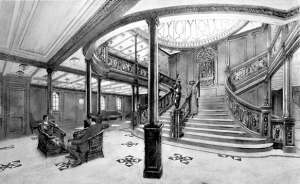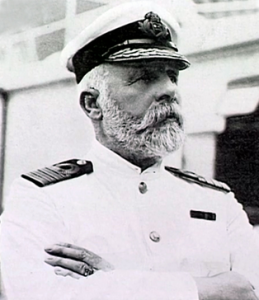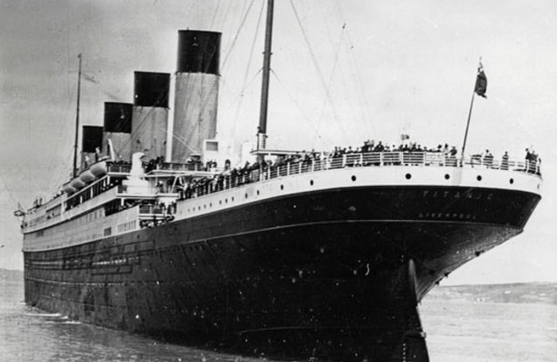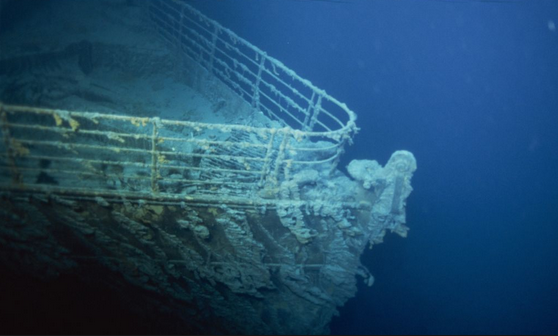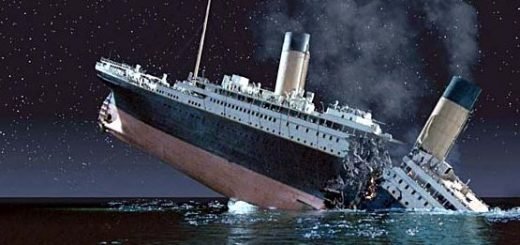Titanic: History and Facts
The RMS (Royal Mail Steamer) Titanic, popularly known as the Titanic, was a luxury British steamship that gained its legendary status as one of the greatest ships of its time. The story behind the sinking of the Titanic is really a heartbreaking one as it resulted in the loss of over 1,500 lives.
Here on this page, we shall focus on the history and most important facts of the Titanic. We shall also delve into some of the reasons that led to the tragic sinking of a ship once dubbed unsinkable.
Construction of the Titanic

The RMS Titanic was constructed at Belfast in Ireland.
The birth of the Titanic was a result of an intense competition that existed between the White Star Line and Cunard. These two Liverpool-based giant shipping line companies challenged each other for dominance in their industry.
Cunard’s two masterpiece ships – the Lusitania and the Mauretania, launched in 1907 – were one of the fastest ocean liners at that time.
As for White Star Line, their bid to be superior to their arch-rivals, Cunard, saw their chief executive officer J. Bruce Ismay meet with William J., the chairman of Harland and Wolff (a renowned shipbuilding company). The two discussed the construction of three Olympic-class huge ships.
The RMS Titanic was the second of the three huge ships to be constructed. The other two sister ships were HMHS Britannic and RMS Olympic.
The construction of the Titanic began in March 1909 at the shipyard of Harland and Wolf shipbuilding Company. The RMS Olympic, one of the other three big ships, was constructed almost the same time as the Titanic. However, the Olympic began quite earlier than the Titanic as its keel was started in December 1908. The construction works took place at Queen’s Island, Belfast in Ireland. Queen’s Island therefore became known as the Titanic Quarters.
It took about 15,000 workers from the Harland and Wolff Building Company to construct the Titanic. As you will expect, injuries and deaths were inevitable owing to the size of the ship and also some of the poor safety working conditions at that time. It is believed that about 28 workers were severely injured. All in all, 9 workers died during the building of the Titanic.
Launching of the Titanic
After about two years of hard work, the Titanic was partially completed. Its partly completed structure was launched on the 31st of May 1911, with over 100,000 people in attendance. After its launch, it took about 22 tons of soap to enable the Titanic’s passage into the River Lagan.
Between 1911 and 1912, after it had been introduced to the public, the gargantuan ship was installed with its engines, interior, and other superstructures. There were also other little changes that were made to the original structure design; however, they were not major alterations.
Famous facilities on the Titanic Ship
The Titanic was fitted with several luxurious facilities that were the highest of standards during its time. In fact, the brain behind the Titanic, particularly, its first-class compartments, were to give passengers a feeling similar to that of a floating high-class hotel. It is no surprise that its interior designs were inspired by the Ritz Hotel in London.
The Titanic’s opulence included: a first-class gymnasium, a 7ft deep swimming pool, a squash court, a Turkish bath, library, and a restaurant. The most outstanding facility on the Titanic was her Grand Staircase, which was constructed in a curvy first-class manner. The Grand staircase linked several of the ship’s decks together.
Sea testing of the Titanic
After the Titanic’s major structures were fully installed, engineers were ready to put the ship to rigorous testing. On 2nd April 1912, the ship was en route for her first testing. Trials began at around 6 o’clock in the morning, with quite a few representatives of different companies, 41 crew members, some firemen, and 78 stokers aboard the ship. After sea trials, which lasted approximately 12 hours, the Titanic was declared seaworthy.
Why the Titanic was considered unsinkable
Before its saddening fate, the luxurious ship liner was referred to as the unsinkable ship. Why? Because it was designed with many advanced safety features, which included waterproof compartments and doors. Its doors were also remote controlled, providing some level of comfort as well as extra safety.
Passengers and crew Members on Titanic’s maiden voyage
On her maiden voyage, the Titanic had aboard her crew members, British and other European emigrants who were seeking for greener pastures in the USA. Aboard the Titanic were also some of the world’s wealthiest people (predominantly accommodated on the liner’s luxurious first-class compartments).
Read More: 15 Famous Survivors from the Titanic Disaster
Crew members aboard the Titanic
The Titanic had 885 crew members, with the majority of them being hired on a casual basis purposely for the trip. Captain Edward John Smith was appointed as Titanic’s captain. He was a senior captain of the White Star Line and previously worked as a captain on the RMS Olympic liner.
The crew aboard the ship was grouped into three major sections: the victualling section had the majority, with 494 crew members, the engine section had 325 members, whereas the deck had only 66 crew members.
Out of the 885 crew members, only 23 of them were female. They worked mainly as stewardesses, attending to passengers on the ship. The rest of the crew were male and worked in a variety of positions, such as laundrymen, cleaners, fishmongers, chefs, bakers, stewards, dishwashers, bed-makers, gymnasium instructors, and butchers.
Passengers aboard the Titanic
The Titanic was designed to accommodate a total number of 2453 passengers on board- 1006 3rd-class passengers; 614 passengers on the 2nd-class compartment; and 833 1st-class passengers. However, due to a national coal strike in the UK (which ended a few days prior to Titanic’s voyage), the gigantic ship found itself acutely under capacity.
As a result, lots of potential passengers postponed their traveling plans until the strike was over. The ship carried only a total of 1317 passengers on board, with 709 third-class passengers, 284 second-class passengers, and 324 first-class passengers.
Did you know…?
Out of a total of 1317 passengers onboard the ship, 869 of them were male whereas 447 were female. 107 of the 1317 passengers were children.
Prominent people on the Titanic
Among the 1314 passengers on the ship’s first voyage were high-profile names, including:
- John Jacob Astor IV along with his spouse Madeleine Force Astor. Jacob was famous for being the wealthiest man on the Titanic. He was also renowned for marrying his wife, Madeline who was only 18 years young at the time of their wedding. Jacob was 29 years older than his wife. Jacob did not survive the disaster, but his wife Madeleine did. Madeline would later die in 1940.
- Macy’s proprietor Isidor Straus and his wife Ida. The couple died on the night of the Titanic’s ill-fated blow.
- Edward Austine Kent, a renowned architect, who lost his life in the disaster.
- Margret “Molly” Brown played an instrumental role in ensuring calm during the evacuation of passengers. After the disaster, she was nicknamed “The Unsinkable Molly Brown”. She survived but passed on in 1932.
- Tennis player Karl Behr. He survived the tragedy.
- Dorothy Gibson who was a film actress, singer, and model. She would go on to star in the first-ever movie about the Titanic’s misfortune but died in 1946.
- J Bruce Ismay was the executive director of White Star Line. He was one of the fortunate persons to survive the tragedy.
- Thomas Andrews, the man who designed the Titanic, which went ahead to claim his life. He died in 1912 on the ship he designed.
- Benjamin Guggenheim together with his mistress Leontine Aubart (she was a French singer). Benjamin was the heir to the Guggenheim mining wealth. He died in 1912 in the tragedy. His famous quote “We’re dressed in our best and prepared to go down like gentlemen” made him even more famous after the adversity.
- Captain Edward John Smith, the seasoned White Star Line ship Captain. He was also known as “The Millionaire’s Captain” and popular for commanding the most luxurious ocean liners of the White Star Line.
- Lady Duff Gordon was a renowned British fashion designer who became the first designer from Britain to achieve international recognition.
- Major Archibald Butt was an astonishing military officer and presidential aide to President Theodore Roosevelt in the year 1908 and President William Howard Taft (in 1909) of the USA. He perished on the night of the disaster.
- William Thomas Stead, a seasoned writer, and journalist. Stead was famous for writing fiction stories. He did not survive the Titanic disaster.
- John B. Thayer was a famous businessman and executive of the Pennsylvania Railroad. He boarded the ship in Cherbourg, France, but could not survive the calamity of 1912.
- Thomas Byles, a priest of the Catholic church who was ordained in 1902. He boarded the Titanic en route to America to officiate his younger sibling’s wedding. He prayed and blessed passengers during the final hours of the sinking ship. Father Byles did not survive the incident.
- Washington Augustus Roebling II. He was a young passionate engineer who designed race cars. His uncle, whom he was named after, was one of the constructors of Brooklyn Bridge. On his return from a tour in Europe, Augustus met his untimely death that unfortunate night the ship sank.
- Charles Melville Hays; a wealthy and extremely successful businessman. He was The Grand Trunk Pacific Railway President and was on board the ship with his wife and daughter. Though he did not survive the catastrophe, he ensured that his wife and daughter were safe that night.
J.P Morgan who was the financier and owner of the International Mercantile Marine Co., which was the parent Company of White Star Line. Morgan was initially scheduled to be aboard the ship. However, his trip was canceled at the last minute due to some delayed business matters.
Read More: Tragic Facts about the Sinking of the Titanic
When did the Titanic set sail?
This legendary ocean liner’s first voyage was on Wednesday, the 10th of April 1912. From Southampton, in England, it headed off to New York City in the USA. Majority of the passengers arrived at around 9:30 in the morning. The third-class ticket holders were the first passengers to board the ship. This was due to their relatively huge numbers compared to the other classes of passengers. First and second class passengers followed up, with Captain Smith personally greeting the first-class passengers upon their arrival aboard.
A total of 920 passengers boarded the ship at Southampton and they comprised 494 passengers on a third-class ticket, 247 passengers on a second-class ticket, and 179 passengers on a first-class ticket.
There were two notable Incidents that occurred on the Titanic before it finally departed the Southampton Dock. The first incident was the discovery of coal fire on one of her coal bunkers. However, the fire was quickly brought under control, though it continued to burn for several more days. Well, even though this was not a strange happening on many steamships, some experts believe that this incident might have led to the Titanic’s unfortunate fate.
Just a few minutes after leaving the Southampton dock en route to her destination in New York; the Titanic almost collided with the relatively smaller S.S City of New York, an American ocean liner. Many concluding that it was the worst possible type of omen that could befall a ship on her maiden voyage.
The Titanic sailed from Southampton to Cherbourg in France, where it picked up more passengers. From Cherbourg, it continued on its way, stopping at Queenstown in Ireland to pick up additional passengers.
The Titanic collides with an Iceberg
Titanic’s voyage continued despite the initial happenings after it departed the Southampton dock. There were also some initial cautions from other ships (precisely, the SS Californian) to the Titanic, informing its officials of floating ice around the area close to Newfoundland. However, the giant ship continued to sail, with Jack Phillips, the senior wireless operator of the Titanic ignoring the warning calls.
On the 14th of April, at around 11:40 in the night, Frederick Fleet, a lookout on the ship spotted an iceberg ahead of the ship and raised alarms. Well, the distance between the ship and the iceberg was too close such that it was impossible for any ship, especially one as big as the Titanic to avoid a collision. The engines were stopped in order to slow down the ship and steer it away from the danger ahead. Any attempt to avoid or mitigate the impact of the collision was rather too late – the ship’s starboard side, below the ship’s waterline, collided with the iceberg.
Did you know…?
Well, prior to the Titanic’s sinking, it was believed that ice caused little threat to big ships. The Titanic was one of the biggest in history (at that time) and therefore did not need to be alarmed.
Water Gushes into the Titanic-Disaster Happens
The Titanic’s sudden end had begun. Sensing that their ship had avoided a severe collision with the iceberg, onlookers seemed to be relieved at that moment. However, they were oblivious to the fact that even though the iceberg did not puncture the hull of the ship, it had caused the hulls’ seems to crumble and detach.
This resulted in water flooding five of the ship’s watertight compartments. Doom set in at this moment because the Titanic could not survive four of its compartments being flooded. With water gushing out of one compartment to another, the giant ship began to sink gradually into the Atlantic.
Evacuation of Passengers

The Titanic’s lifeboats were insufficient to successfully convey all the passengers and crew aboard to safety.
Knowing that the situation was heading for the worst, the ship’s Captain Smith ordered for the loading of passengers on lifeboats. He estimated that it would take around 1 hour 30 minutes for the ship to finally sink (even though it eventually took about 3 hours).
The crew and passengers on board were really not prepared for such a disaster, especially considering the fact that they were onboard one of the biggest ships on the planet at the time.
There were several distress calls made but to no avail. The reason was that none of the responding ships were close enough to come to the help of the sinking Titanic.
However, there were some claims that the SS Californian (which at the time of the incident was the closest ship to the Titanic) had ignored the ship’s distress calls as well as the Titanic’s signal rockets.
Titanic’s Lifeboats
Compounding the Titanic’s problem was the fact that the Titanic had insufficient lifeboats to convey the majority of the passengers and crew members to safety. The ship had on board a total of only 20 (14 standard wooden boats, 4 canvas made collapsible boats, and 2 emergency cutters) lifeboats, which were only enough to carry up to 1178 persons.
During the evacuation process, which was done in a rather chaotic manner, some of the lifeboats were not fully loaded. The first lifeboat had the capacity to carry 65 persons but was only loaded with 28 people. This trend continued, with roughly 700 passengers and crew members seeking shelter on all available lifeboats, even though the total lifeboats on board had the capacity to carry at least half the number of persons on the ship.
In such occurrences, the sea laws required that women and children were the first to board the lifeboats. Men were only permitted to board lifeboats when there were no available women and children. This was reflected in the proportion number of lives lost, with a higher proportion of women and children being rescued.
The chaos intensified as the water level in the ship kept on rising, leaving it in a very dire state with little lifeboats left. This led to several heartbreaking occurrences, as well as some acts of bravery. Lots of families and loved ones were separated, with some men seeing off their wives and children as the situation became more and more helpless. Others gave up their seats on the lifeboat in order to allow the more vulnerable individuals to flee, whereas others opted to remain with their partners on the sinking ship.
The Titanic’s Final Minutes
The chief designer of the Titanic, Thomas Andrew bid his pregnant wife, Madeleine farewell as she departed for safety on one of few lifeboats left. He was last seen gazing at one of the paintings on the wall of the first-class smoking room.
Isidor Straus and his wife opted to remain on the sinking ship even though they were offered an opportunity to flee on one of the lifeboats.
During the final minutes of the sinking Titanic, Benjamin Guggenheim’s legendary statement- “We are dressed in our best and are prepared to go down like gentlemen” would go down as one of the most touching declarations made on the ship.
The Titanic Sinks
On April 15th around 2:20 at dawn, the Titanic, breaking into two halves, finally plunged and was no longer visible atop the surface of the ocean. The passengers and crew who still remained on the ship were all immersed into the icy ocean. With temperatures around -2 degrees Celsius, it is highly unlikely that many will survive such conditions. It is believed that the majority of the victims died from cardiac arrest or as a result of body reactions to the extremely cold sea. Only 13 of the victims were eventually rescued from the freezing sea onto the lifeboats. The Titanic’s chef was one of them.
The same day, at around 4:00 at dawn, the RMS Carpathia arrived at the site of the incident after responding to the Titanic’s earlier call for distress. A total of around 710 passengers and crew members were rescued onto the Carpathia and conveyed to New York.
Aftermath of the Sinking of the Titanic
After departing the scene of the incident, it took the Carpathia about 3 days to finally arrive at the New York’s Pier 54 with its passengers and the rescued victims from the Titanic. Upon hearing the news of the tragic incident, hundreds of thousands of people gathered at the New York’s Pier 54, awaiting the Carpathia’s arrival. The Carpathia finally arrived on the 18th of April and docked at around 9: 30 in the night.
Several inquiries and investigations were made into the unfortunate disaster that lead to the loss of thousands of lives and property. Thorough investigations were made, with several questions thrown at the surviving crew members and even at the initial construction of the ship. Maritime experts and other disaster experts were also consulted for their opinions. Surviving passengers and the Captain of the Carpathia also gave their own versions of the incident.
Movies and Songs about the Titanic Disaster
After the unfortunate disaster, which resulted in the loss of over 1500 lives, there have so far been multiple movies and songs about the ship’s tragedy. The first film that was released on the Titanic was titled – Saved from the Titanic. It featured Dorothy Gibson, one of the few survivors of the disaster. It was released barely 30 days after the incident.
A British film titled A Night to Remember, which was released in 1958, was also another very popular movie that portrays a very accurate episode of the Titanic’s tragedy.
So far, the most successful episode of the Titanic’s incident is the movie titled – Titanic. Released in 1997, the Titanic has won several Oscars, including the award for Best Picture. The film’s director James Cameron won an award for Best Director at the 70th Academy Awards.
One of the best songs released about the Titanic is “My Heart Will Go On”. It was recorded by Celine Dion and it was the theme song for the Titanic (1997) movie.
Discovery of the Titanic’s Wreckage
The wreck of the Titanic ship was unearthed by explorers on the 1st of September 1985, which is about 74 years since it sank. The wreck lies over 12,000 ft below the surface of the Atlantic Ocean. The leader of the mission was Robert Ballard, who discovered that the Titanic actually ripped into two halves before making contact with the ocean floor of the Atlantic. The two halves of the ship lay approximately 0.6 km apart around the coast of Newfoundland.
A number of artifacts have been retrieved from the seabed where the Titanic’s wreck lays. Several of these artifacts have been on display in exhibitions in the USA and other touring exhibitions around the globe.
More Facts about the Titanic
- Route: Southampton, UK to New York City, USA.
- Port of Registration: Liverpool, United Kingdom.
- Length: 882ft, 9” (269.1m)
- Height: 175ft (53.3m)
- Weight: 52,310 tons
- Depth: 64ft, 6” (19.7m)
- Owner: White Star Line.
- Constructors: Harland and Wolff.
- Number of Decks: In addition to the officers’ quarters, located at the top, the Titanic had 10 decks (8 of them being passenger decks).
- Place of Construction: Belfast, Ireland.
- The Titanic was the biggest artificially constructed moving object during its era.
- The ocean liner used about 600 tons of coal each day, with up to 100 tons of ash expelled into the sea every day.
- A great number of the passengers aboard the ship were third-class passengers.
- The richest man on the Titanic was John Jacob Astor IV, an American millionaire. His net worth was estimated to be in the region of 85 million Dollars at that time.
- Millvina Dean was the last known survivor of the Titanic catastrophe. She was only two months old when the ship sank. She passed away on 31st May 2009.
- The iceberg that led to the plunging of the Titanic was about 100 feet in height. It was believed to have come from a glacier in Greenland.
- The Titanic’s 16-ton center anchor was the largest ever constructed by hand during its time.
- Newfoundland was the nearest destination to the Titanic when it sank. The ship was 400 miles away from Newfoundland.
- The interior of the ship was inspired by a London based hotel – The Ritz, located in Piccadilly.
- It cost about 1.5 million Pounds Sterling to construct the Titanic.
- The Titanic’s wreck was discovered in 1985.
- There were no gold, diamonds or exotic minerals aboard the ship.
Did the Titanic Carry Only Passengers?
The Titanic was mainly a passenger ship. However, she also carried a significant amount of cargo during her first voyage. This ocean liner was contracted to carry and deliver mail and other valuable items for the Royal Mail and also the United States Post Office Department.
Most Valuable Items Lost in Titanic’s disaster
During the unfortunate demise of the Titanic, one of the most valuable items that got missing was a painting by French artist, Mary-Joseph Blondel, titled La Circassienne au Bain. It belonged to Mauritz Hakan Bjornstrom-Stefansson, who was a first-class passenger on the ship. He survived though, and after the incident, it is believed that he sued for a $ 100,000 compensation for the loss of an artwork that belonged to him.
Another valuable item that got lost in the shipwreck was a copy of the Rubaiyat of Omar Khayyan. It was valued at merely £405 at that time.
Summary
Well, there you have it, every important fact regarding the history of the Titanic – one of the world’s greatest ships and maritime disasters of all time. The Titanic will eternally live in the memories of many for its fascinating and tragic story. One that went from being an “Unsinkable ship” to being shattered on her first journey across the Atlantic Ocean, sending distress and sorrow all over the world.
FACT CHECK: At World History Edu, we strive for utmost accuracy and objectivity. But if you come across something that doesn’t look right, don’t hesitate to leave a comment below.
